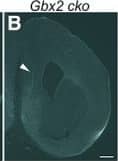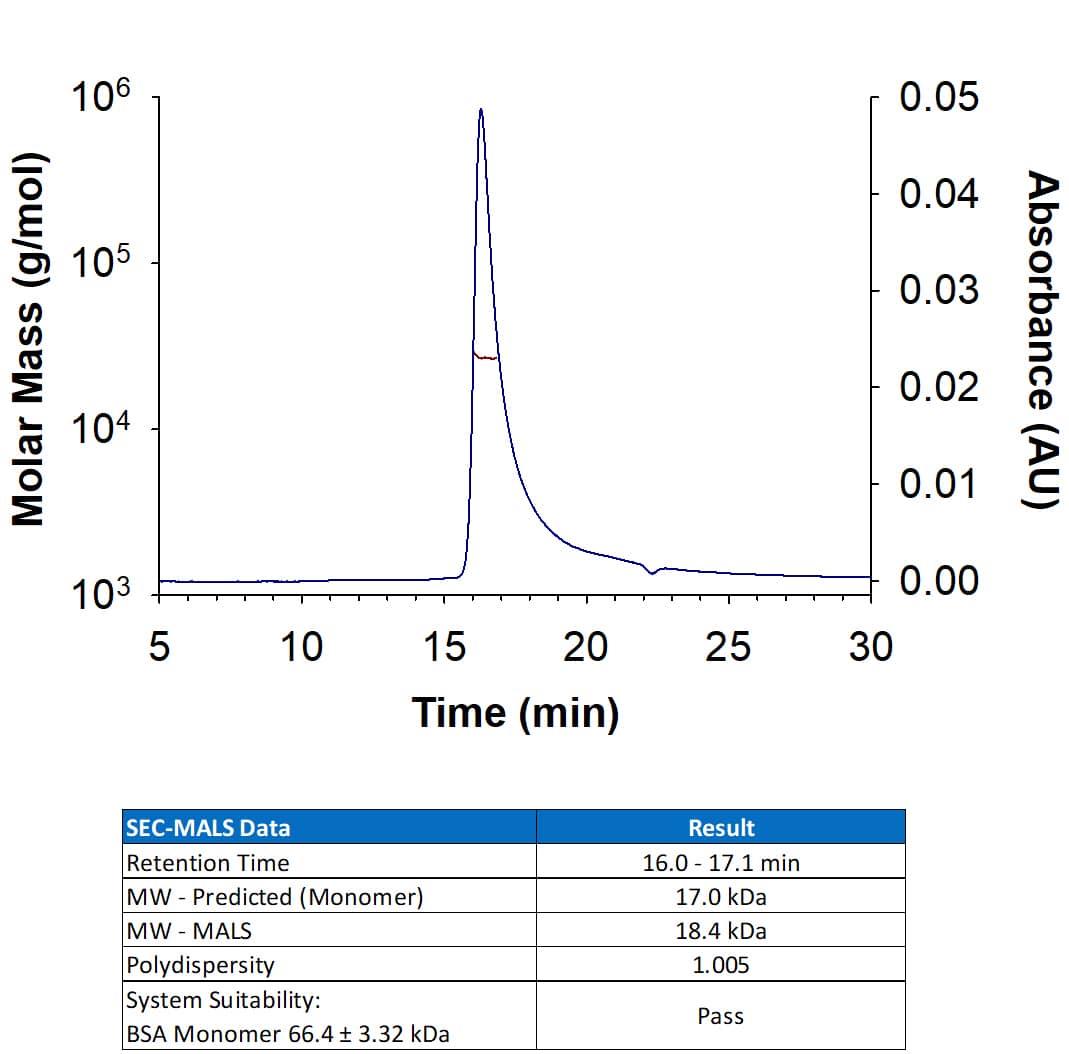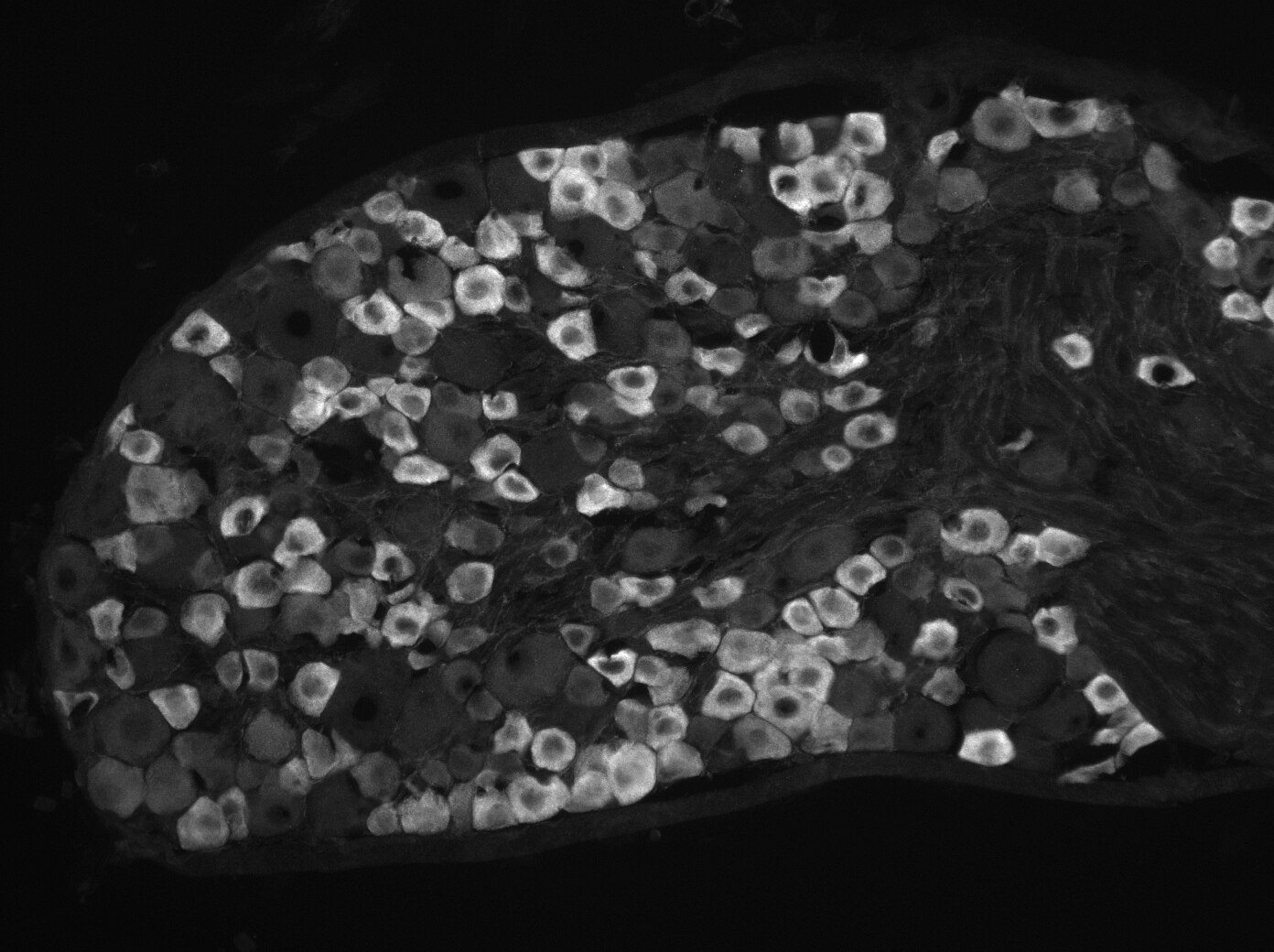Mouse Plexin C1 Antibody Summary
Ala35-Thr950
Accession # Q9QZC2
Customers also Viewed
Applications
Please Note: Optimal dilutions should be determined by each laboratory for each application. General Protocols are available in the Technical Information section on our website.
Scientific Data
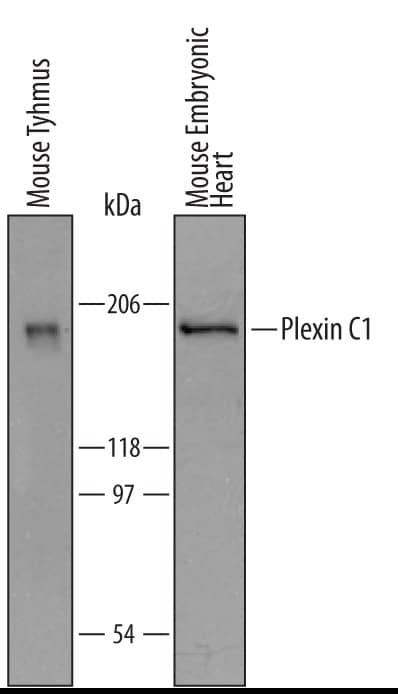 View Larger
View Larger
Detection of Mouse Plexin C1 by Western Blot. Western blot shows lysates of mouse thymus tissue and embryonic mouse heart tissue. PVDF membrane was probed with 1 µg/mL of Sheep Anti-Mouse Plexin C1 Antigen Affinity-purified Polyclonal Antibody (Catalog # AF5375) followed by HRP-conjugated Anti-Sheep IgG Secondary Antibody (Catalog # HAF016). A specific band was detected for Plexin C1 at approximately 200 kDa (as indicated). This experiment was conducted under reducing conditions and using Immunoblot Buffer Group 8.
 View Larger
View Larger
Detection of Plexin C1 in Mouse Splenocytes by Flow Cytometry. Mouse splenocytes were stained with Sheep Anti-Mouse Plexin C1 Antigen Affinity-purified Polyclonal Antibody (Catalog # AF5375, filled histogram) or control antibody (Catalog # 5-001-A, open histogram), followed by NorthernLights™ 637-conjugated Anti-Sheep IgG Secondary Antibody (Catalog # NL011).
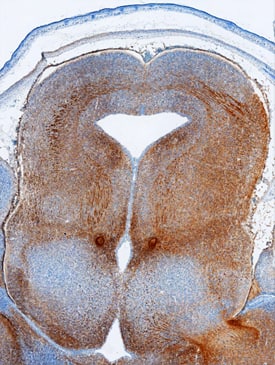 View Larger
View Larger
Plexin C1 in Mouse Embryo. Plexin C1 was detected in immersion fixed frozen sections of mouse embryo (15 d.p.c.) using Sheep Anti-Mouse Plexin C1 Antigen Affinity-purified Polyclonal Antibody (Catalog # AF5375) at 5 µg/mL overnight at 4 °C. Tissue was stained using the Anti-Sheep HRP-DAB Cell & Tissue Staining Kit (brown; Catalog # CTS019) and counterstained with hematoxylin (blue). Specific staining was localized to neurites in the developing midbrain. View our protocol for Chromogenic IHC Staining of Frozen Tissue Sections.
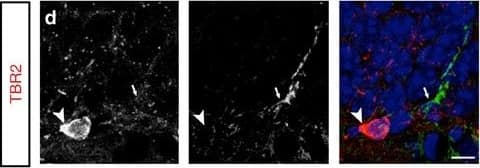 View Larger
View Larger
Detection of Mouse Plexin C1 by Immunocytochemistry/Immunofluorescence PlexinC1 expression in the subgranular zone is largely confined to early progenitors.(a–f) Double immunohistochemistry for plexinC1 and Ki-67 (a), glial fibrillary acidic protein (GFAP; b), sex determining region Y-box 2 (Sox2; c), t-box brain 2 (TBR2; d), doublecortin (DCX; e) or neuronal nuclei (NeuN; f) in sections of the adult mouse dentate gyrus (DG). The majority of plexinC1-positive cells express Ki-67, GFAP and Sox2 but not TBR2, DCX or NeuN. Arrowheads indicate cells expressing specific markers. Arrows indicate plexinC1-positive cells not expressing the indicated marker. (g,h) Quantification of the fraction of cells expressing a specific marker that also express plexinC1 (g) or the fraction of plexinC1-positive cells that also express the indicated marker protein (h). Data are presented as means±s.e.m. n≥3 (mice). (i) Schematic representation of lineage-marker and plexinC1 expression in cell lineage subtypes during neuronal differentiation in the adult DG. Ki-67 is a marker for proliferating cells during all active phases of the cell cycle. PlexinC1 is expressed in GFAP-positive and Sox2-positive radial glia-like cells (RGLs) and early intermediate progenitor cells (IPCs). Ki-67-positive proliferating cells express plexinC1. In contrast, only a small fraction of TBR2-, DCX- or NeuN-positive intermediate progenitor cells and (immature) granule cells express plexinC1. Scale bars: 10 μm. Image collected and cropped by CiteAb from the following publication (https://www.nature.com/articles/ncomms14666), licensed under a CC-BY license. Not internally tested by R&D Systems.
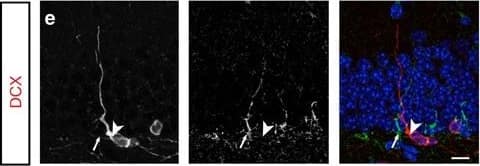 View Larger
View Larger
Detection of Mouse Plexin C1 by Immunocytochemistry/Immunofluorescence PlexinC1 expression in the subgranular zone is largely confined to early progenitors.(a–f) Double immunohistochemistry for plexinC1 and Ki-67 (a), glial fibrillary acidic protein (GFAP; b), sex determining region Y-box 2 (Sox2; c), t-box brain 2 (TBR2; d), doublecortin (DCX; e) or neuronal nuclei (NeuN; f) in sections of the adult mouse dentate gyrus (DG). The majority of plexinC1-positive cells express Ki-67, GFAP and Sox2 but not TBR2, DCX or NeuN. Arrowheads indicate cells expressing specific markers. Arrows indicate plexinC1-positive cells not expressing the indicated marker. (g,h) Quantification of the fraction of cells expressing a specific marker that also express plexinC1 (g) or the fraction of plexinC1-positive cells that also express the indicated marker protein (h). Data are presented as means±s.e.m. n≥3 (mice). (i) Schematic representation of lineage-marker and plexinC1 expression in cell lineage subtypes during neuronal differentiation in the adult DG. Ki-67 is a marker for proliferating cells during all active phases of the cell cycle. PlexinC1 is expressed in GFAP-positive and Sox2-positive radial glia-like cells (RGLs) and early intermediate progenitor cells (IPCs). Ki-67-positive proliferating cells express plexinC1. In contrast, only a small fraction of TBR2-, DCX- or NeuN-positive intermediate progenitor cells and (immature) granule cells express plexinC1. Scale bars: 10 μm. Image collected and cropped by CiteAb from the following publication (https://www.nature.com/articles/ncomms14666), licensed under a CC-BY license. Not internally tested by R&D Systems.
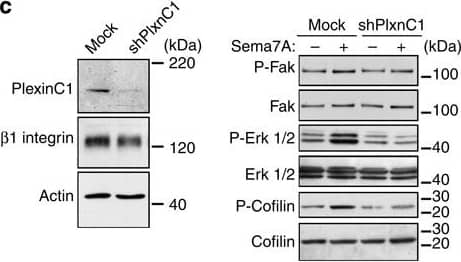 View Larger
View Larger
Detection of Mouse Plexin C1 by Knockdown Validated Sema7A induces the retraction of GnRH neurites through the PlexinC1 transduction pathway and Rap1 inactivation.(a) Representative images of semaphorin-induced neurite retraction in GnV3 neurons transfected with an empty vector (mock), a construct encoding a PlexinC1 short hairpin RNA (GnV3 shRNA PlexinC1) or a Rap1-V12 plasmid encoding a constitutively active form of Rap1. One day following Sema7A treatment (250 ng ml−1), cells were labelled for F-actin (red) to visualize cytoskeletal changes. (b) Quantitative analysis of neurite length in GnV3 cells under different treatment conditions (n=5 independent experiments, n=303 mock-transfected control cells, n=303 mock-transfected cells after Sema7A treatment, unpaired Student’s t-test, ***P<0.0001; n=267 shPlxnC1-treated cells, n=235 shPlxnC1+Sema7A-treated cells, unpaired Student’s t-test, P>0.05; n=131 Rap1-V12-transfected cells, n=115 Rap1-V12-transfected cells+Sema7A, unpaired Student’s t-test, P>0.05). (c) Immunoblotting for markers indicated using transfected GnV3 cells. (d–f) Saline, Sema7A or Sema7A+PlexinC1 was infused (0.2 μg μl−1, 0.5 μl h−1 for 7 days) by stereotaxic implantation of a 28-gauge infusion cannula connected to a subcutaneously implanted mini-osmotic pump in the ME of cycling female rats. Representative oestrous cycle profiles showing the disruption of oestrous cyclicity by the infusion of Sema7A but not of PBS into the ME. Infusion was started on day 9 (downward arrow) and ended 7 days later (upward arrow), when pump contents were exhausted. Die, Diestrus; Es, estrus; Pro, proestrus. (g) Quantitative analysis of alterations in ovarian cyclicity (percentage of time in diestrus) caused by PBS, Sema7A or Sema7A+soluble PlexinC1 infusion into the rat ME (n=6 animals per group, Kruskal–Wallis test, **P<0.005). Scale bar, (a) 10 μm. Image collected and cropped by CiteAb from the following publication (https://pubmed.ncbi.nlm.nih.gov/25721933), licensed under a CC-BY license. Not internally tested by R&D Systems.
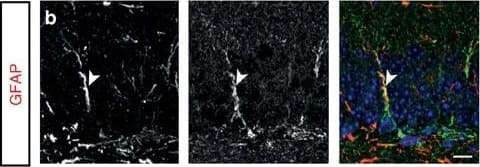 View Larger
View Larger
Detection of Mouse Plexin C1 by Immunocytochemistry/Immunofluorescence PlexinC1 expression in the subgranular zone is largely confined to early progenitors.(a–f) Double immunohistochemistry for plexinC1 and Ki-67 (a), glial fibrillary acidic protein (GFAP; b), sex determining region Y-box 2 (Sox2; c), t-box brain 2 (TBR2; d), doublecortin (DCX; e) or neuronal nuclei (NeuN; f) in sections of the adult mouse dentate gyrus (DG). The majority of plexinC1-positive cells express Ki-67, GFAP and Sox2 but not TBR2, DCX or NeuN. Arrowheads indicate cells expressing specific markers. Arrows indicate plexinC1-positive cells not expressing the indicated marker. (g,h) Quantification of the fraction of cells expressing a specific marker that also express plexinC1 (g) or the fraction of plexinC1-positive cells that also express the indicated marker protein (h). Data are presented as means±s.e.m. n≥3 (mice). (i) Schematic representation of lineage-marker and plexinC1 expression in cell lineage subtypes during neuronal differentiation in the adult DG. Ki-67 is a marker for proliferating cells during all active phases of the cell cycle. PlexinC1 is expressed in GFAP-positive and Sox2-positive radial glia-like cells (RGLs) and early intermediate progenitor cells (IPCs). Ki-67-positive proliferating cells express plexinC1. In contrast, only a small fraction of TBR2-, DCX- or NeuN-positive intermediate progenitor cells and (immature) granule cells express plexinC1. Scale bars: 10 μm. Image collected and cropped by CiteAb from the following publication (https://www.nature.com/articles/ncomms14666), licensed under a CC-BY license. Not internally tested by R&D Systems.
 View Larger
View Larger
Detection of Mouse Plexin C1 by Immunocytochemistry/Immunofluorescence PlexinC1 expression in the subgranular zone is largely confined to early progenitors.(a–f) Double immunohistochemistry for plexinC1 and Ki-67 (a), glial fibrillary acidic protein (GFAP; b), sex determining region Y-box 2 (Sox2; c), t-box brain 2 (TBR2; d), doublecortin (DCX; e) or neuronal nuclei (NeuN; f) in sections of the adult mouse dentate gyrus (DG). The majority of plexinC1-positive cells express Ki-67, GFAP and Sox2 but not TBR2, DCX or NeuN. Arrowheads indicate cells expressing specific markers. Arrows indicate plexinC1-positive cells not expressing the indicated marker. (g,h) Quantification of the fraction of cells expressing a specific marker that also express plexinC1 (g) or the fraction of plexinC1-positive cells that also express the indicated marker protein (h). Data are presented as means±s.e.m. n≥3 (mice). (i) Schematic representation of lineage-marker and plexinC1 expression in cell lineage subtypes during neuronal differentiation in the adult DG. Ki-67 is a marker for proliferating cells during all active phases of the cell cycle. PlexinC1 is expressed in GFAP-positive and Sox2-positive radial glia-like cells (RGLs) and early intermediate progenitor cells (IPCs). Ki-67-positive proliferating cells express plexinC1. In contrast, only a small fraction of TBR2-, DCX- or NeuN-positive intermediate progenitor cells and (immature) granule cells express plexinC1. Scale bars: 10 μm. Image collected and cropped by CiteAb from the following publication (https://www.nature.com/articles/ncomms14666), licensed under a CC-BY license. Not internally tested by R&D Systems.
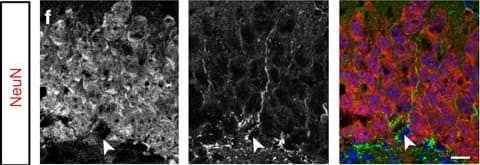 View Larger
View Larger
Detection of Mouse Plexin C1 by Immunocytochemistry/Immunofluorescence PlexinC1 expression in the subgranular zone is largely confined to early progenitors.(a–f) Double immunohistochemistry for plexinC1 and Ki-67 (a), glial fibrillary acidic protein (GFAP; b), sex determining region Y-box 2 (Sox2; c), t-box brain 2 (TBR2; d), doublecortin (DCX; e) or neuronal nuclei (NeuN; f) in sections of the adult mouse dentate gyrus (DG). The majority of plexinC1-positive cells express Ki-67, GFAP and Sox2 but not TBR2, DCX or NeuN. Arrowheads indicate cells expressing specific markers. Arrows indicate plexinC1-positive cells not expressing the indicated marker. (g,h) Quantification of the fraction of cells expressing a specific marker that also express plexinC1 (g) or the fraction of plexinC1-positive cells that also express the indicated marker protein (h). Data are presented as means±s.e.m. n≥3 (mice). (i) Schematic representation of lineage-marker and plexinC1 expression in cell lineage subtypes during neuronal differentiation in the adult DG. Ki-67 is a marker for proliferating cells during all active phases of the cell cycle. PlexinC1 is expressed in GFAP-positive and Sox2-positive radial glia-like cells (RGLs) and early intermediate progenitor cells (IPCs). Ki-67-positive proliferating cells express plexinC1. In contrast, only a small fraction of TBR2-, DCX- or NeuN-positive intermediate progenitor cells and (immature) granule cells express plexinC1. Scale bars: 10 μm. Image collected and cropped by CiteAb from the following publication (https://www.nature.com/articles/ncomms14666), licensed under a CC-BY license. Not internally tested by R&D Systems.
 View Larger
View Larger
Detection of Mouse Plexin C1 by Immunocytochemistry/Immunofluorescence PlexinC1 expression in the subgranular zone is largely confined to early progenitors.(a–f) Double immunohistochemistry for plexinC1 and Ki-67 (a), glial fibrillary acidic protein (GFAP; b), sex determining region Y-box 2 (Sox2; c), t-box brain 2 (TBR2; d), doublecortin (DCX; e) or neuronal nuclei (NeuN; f) in sections of the adult mouse dentate gyrus (DG). The majority of plexinC1-positive cells express Ki-67, GFAP and Sox2 but not TBR2, DCX or NeuN. Arrowheads indicate cells expressing specific markers. Arrows indicate plexinC1-positive cells not expressing the indicated marker. (g,h) Quantification of the fraction of cells expressing a specific marker that also express plexinC1 (g) or the fraction of plexinC1-positive cells that also express the indicated marker protein (h). Data are presented as means±s.e.m. n≥3 (mice). (i) Schematic representation of lineage-marker and plexinC1 expression in cell lineage subtypes during neuronal differentiation in the adult DG. Ki-67 is a marker for proliferating cells during all active phases of the cell cycle. PlexinC1 is expressed in GFAP-positive and Sox2-positive radial glia-like cells (RGLs) and early intermediate progenitor cells (IPCs). Ki-67-positive proliferating cells express plexinC1. In contrast, only a small fraction of TBR2-, DCX- or NeuN-positive intermediate progenitor cells and (immature) granule cells express plexinC1. Scale bars: 10 μm. Image collected and cropped by CiteAb from the following publication (https://www.nature.com/articles/ncomms14666), licensed under a CC-BY license. Not internally tested by R&D Systems.
Preparation and Storage
- 12 months from date of receipt, -20 to -70 °C as supplied.
- 1 month, 2 to 8 °C under sterile conditions after reconstitution.
- 6 months, -20 to -70 °C under sterile conditions after reconstitution.
Background: Plexin C1
Plexin C1 (also VESPR and CD232) is a 200‑210 kDa member of the plexin C subfamily, plexin family of proteins. It is a type I transmembrane glycoprotein that is found on monocytes, dendritic cells, neutrophils and embryonic neuroendocrine neurons of the hyypothalamus. Plexin C1 binds Sema7A, and its viral counterpart, vaccinia semaphorin A39R. Ligation induces actin cytoskeletal rearrangement and cell immobilization. Mature mouse Plexin C1 is 1540 amino acids (aa) in length. It contains a 916 aa extracellular domain that shows one Sema-domain (aa 35‑452) and a 603 aa cytoplasmic tail. There are two potential splice variants that show a five and 67 aa substitution for aa 861‑870 and 1206‑1574, respectively. Over aa 35‑950, mouse Plexin C1 is 95% and 85% aa identical to rat and human Plexin C1, respectively.
Product Datasheets
Citations for Mouse Plexin C1 Antibody
R&D Systems personnel manually curate a database that contains references using R&D Systems products. The data collected includes not only links to publications in PubMed, but also provides information about sample types, species, and experimental conditions.
9
Citations: Showing 1 - 9
Filter your results:
Filter by:
-
Plexin C1 influences immune response to intracellular LPS and survival in murine sepsis
Authors: Bernard, A;Eggstein, C;Tang, L;Keller, M;Körner, A;Mirakaj, V;Rosenberger, P;
Journal of biomedical science
Species: Mouse
Sample Types: Cell Lysates
Applications: Western Blot -
c-Maf-positive spinal cord neurons are critical elements of a dorsal horn circuit for mechanical hypersensitivity in neuropathy
Authors: N Frezel, M Ranucci, E Foster, H Wende, P Pelczar, R Mendes, RP Ganley, K Werynska, S d'Aquin, C Beccarini, C Birchmeier, HU Zeilhofer, H Wildner
Cell Reports, 2023-03-21;42(4):112295.
Species: Mouse
Sample Types: Whole Tissue
Applications: IHC -
Inhibitory Kcnip2 neurons of the spinal dorsal horn control behavioral sensitivity to environmental cold
Authors: Gioele W. Albisetti, Robert P. Ganley, Francesca Pietrafesa, Karolina Werynska, Marília Magalhaes de Sousa, Rebecca Sipione et al.
Neuron
-
Guidance landscapes unveiled by quantitative proteomics to control reinnervation in adult visual system
Authors: N Vilallongu, J Schaeffer, AM Hesse, C Delpech, B Blot, A Paccard, E Plissonnie, B Excoffier, Y Couté, S Belin, H Nawabi
Nature Communications, 2022-10-13;13(1):6040.
Species: Mouse
Sample Types: Whole Tissue
Applications: IHC -
Endothelial semaphorin 7A promotes seawater aspiration-induced acute lung injury through plexin C1 and beta 1 integrin
Authors: Minlong Zhang, Xue Yan, Wei Liu, Ruilin Sun, Yonghong Xie, Faguang Jin
Molecular Medicine Reports
-
Rewiring the taste system
Authors: H Lee, LJ Macpherson, CA Parada, CS Zuker, NJP Ryba
Nature, 2017-08-09;548(7667):330-333.
Species: Mouse
Sample Types: Whole Tissue
Applications: IHC -
Unbiased classification of sensory neuron types by large-scale single-cell RNA sequencing.
Authors: Usoskin D, Furlan A, Islam S, Abdo H, Lonnerberg P, Lou D, Hjerling-Leffler J, Haeggstrom J, Kharchenko O, Kharchenko P, Linnarsson S, Ernfors P
Nat Neurosci, 2014-11-24;18(1):145-53.
Species: Mouse
Sample Types: Whole Tissue
Applications: IHC -
Semaphorin7A regulates neuroglial plasticity in the adult hypothalamic median eminence.
Authors: Parkash J, Messina A, Langlet F, Cimino I, Loyens A, Mazur D, Gallet S, Balland E, Malone S, Pralong F, Cagnoni G, Schellino R, De Marchis S, Mazzone M, Pasterkamp R, Tamagnone L, Prevot V, Giacobini P
Nat Commun, 2015-02-27;6(0):6385.
-
Transcriptional repression of Plxnc1 by Lmx1a and Lmx1b directs topographic dopaminergic circuit formation
Authors: A Chabrat, G Brisson, H Doucet-Bea, C Salesse, M Schaan Pro, A Dovonou, C Akitegetse, J Charest, S Lemstra, D Côté, RJ Pasterkamp, MI Abrudan, E Metzakopia, SL Ang, M Lévesque
Nat Commun, 2017-10-16;8(1):933.
FAQs
No product specific FAQs exist for this product, however you may
View all Antibody FAQsIsotype Controls
Reconstitution Buffers
Secondary Antibodies
Reviews for Mouse Plexin C1 Antibody
Average Rating: 4.5 (Based on 2 Reviews)
Have you used Mouse Plexin C1 Antibody?
Submit a review and receive an Amazon gift card.
$25/€18/£15/$25CAN/¥75 Yuan/¥2500 Yen for a review with an image
$10/€7/£6/$10 CAD/¥70 Yuan/¥1110 Yen for a review without an image
Filter by:
- 1hr block (room temp.) in antibody diluent (0.2% Triton-X + 5% Donkey Serum + 1% BSA in PBS pH7.4)
- Antibody diluted in above 1:400 and mouse dorsal root ganglia sections incubated overnight at 4oC.
- Sections were washed 3x 5mins then incubated for 2hrs (room temp.) in 1:1000 Donkey anti-Sheep IgG conjugated to Alexa Fluor-488 before washing, and coverslipping.







